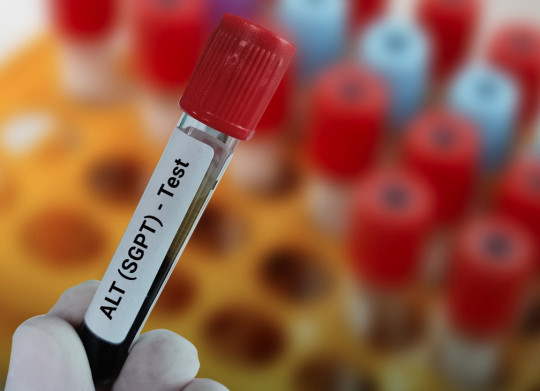#oxaloacetate
Text
The carbon skeleton for amino acids derives from 3-phosphoglycerate, phosphophenolpyruvate, or pyruvate generated during glycolysis, or from 2-oxoglutarate or oxaloacetate generated in the citric acid cycle (Figure 13.8).

"Plant Physiology and Development" int'l 6e - Taiz, L., Zeiger, E., Møller, I.M., Murphy, A.
#book quotes#plant physiology and development#nonfiction#textbook#carbon skeleton#amino acid#citric acid cycle#pyruvate#glucose#glutamate#oxaloacetate#aspartate#serine#tyrosine#phenylalanine#tryptophan#alanine#valine#leucine
0 notes
Text
Initially, the acetyl-CoA reacts with oxaloacetate to give citrate, which is then transferred to the cytoplasm for isomerization to isocitrate by aconitase.
"Plant Physiology and Development" int'l 6e - Taiz, L., Zeiger, E., Møller, I.M., Murphy, A.
#book quote#plant physiology and development#nonfiction#textbook#chemical reaction#oxaloacetate#citrate#cytoplasm#isomer#isomerization#isocitrate#aconitase
0 notes
Text
when I inevitably fail my mocks this week/next I don't think my teachers are going to take "was too mentally ill about a minecraft series" as an excuse you know,,
#this is /hj#BUT there is one teacher i am THIS close to cryin at#because he CANNOT TEACH#and ive complained about him TWICE and nothing has been done to fix the problem (the problem is HIM)#and so now im struggling with my goddamn hazards geography aka the biggest damn part of my geo paper#chem and bio are fine. theyre entirely different beasts and organic synthesis is slowly finishing me off#but we're fine. we're rolling with bio. loving oxaloacetate and acetyl CoA and all the damn shit that comes with bioenergetics now#oooh yeah lets call it a proton motive force thats so fun. how about i call you stupid?#yeah lets make things really hard to spell. and what if i killrd you?#/lh#i love bio
25 notes
·
View notes
Text
I hate it when some people get hostile after I ask them an innocent question. Like, what did I do to you to make you treat me like I’m the scum of the earth???
#delta86 talks#vent#I asked someone in my biochem class why#the removal of CO2 from oxaloacetate#in the gluconeogenisis pathway inhibits glycolysis#and they said “’because it removes CO2’ in the most hostile and condescending tone possible#like no shit I already knew that asshole#I wanted to know why the removal of specifically CO2 inhibited glycolysis. they didn’t answer my question and I had to spend 15 minutes#searching for an answer that could’ve been explained in just a few words#I think you can tell this made me somewhat upset lmao
8 notes
·
View notes
Text
0 notes
Text
🔬🌀Demystifying the Krebs Cycle: A Deep Dive into Cellular Respiration! 🌀🔬
Prepare for a thrilling journey into the heart of cellular metabolism! 🌟✨ Today, we unravel the intricacies of the Krebs Cycle, also known as the Citric Acid Cycle or Tricarboxylic Acid Cycle, a cornerstone of energy production in our cells. 💡🤯
The Krebs Cycle: Named after its discoverer, Sir Hans Krebs, this metabolic pathway occurs within the mitochondria and is a central hub in cellular respiration.
🔍Step 1: Acetyl-CoA Entry
Acetyl-CoA, derived from the breakdown of glucose or fatty acids, enters the cycle.
It combines with oxaloacetate to form citrate, a six-carbon compound.
🔍Step 2: Isocitrate Formation
A rearrangement converts citrate into isocitrate.
The enzyme aconitase facilitates this transformation.
🔍Step 3: Alpha-Ketoglutarate Production
Isocitrate undergoes oxidative decarboxylation, shedding a CO2 molecule and yielding alpha-ketoglutarate.
NAD+ is reduced to NADH in this step.
🔍Step 4: Succinyl-CoA Synthesis
Alpha-ketoglutarate loses CO2 and acquires a CoA group to form succinyl-CoA.
Another NAD+ is reduced to NADH.
This step is catalyzed by alpha-ketoglutarate dehydrogenase.
🔍Step 5: Succinate Formation
Succinyl-CoA releases CoA, becoming succinate.
A molecule of GTP (guanosine triphosphate) is generated as a high-energy phosphate bond.
Succinate dehydrogenase is pivotal, transferring electrons to the electron transport chain (ETC).
🔍Step 6: Fumarate Generation
Succinate is oxidized to fumarate with the help of the enzyme succinate dehydrogenase.
FADH2 (flavin adenine dinucleotide) is formed and transfers electrons to the ETC.
🔍Step 7: Malate Formation
Fumarate undergoes hydration to form malate, catalyzed by fumarase.
🔍Step 8: Regeneration of Oxaloacetate
Malate is oxidized back to oxaloacetate.
NAD+ is reduced to NADH.
Oxaloacetate is ready to initiate another round of the Krebs Cycle.
The Krebs Cycle - an intricate dance of chemical transformations fueling the cellular machinery of life. 🕺💃 Dive deeper into cellular respiration, where molecules tango to generate ATP, our cellular energy currency!

📚References for In-Depth Exploration📚
Berg, J. M., Tymoczko, J. L., & Stryer, L. (2002). Biochemistry (5th ed.). W. H. Freeman. Chapter 17.
Voet, D., Voet, J. G., & Pratt, C. W. (2008). Fundamentals of Biochemistry (3rd ed.). John Wiley & Sons. Chapter 17.
Lehninger, A. L., Nelson, D. L., & Cox, M. M. (2008). Lehninger Principles of Biochemistry (5th ed.). W. H. Freeman. Chapter 17.
#science#biology#college#education#school#student#medicine#doctors#health#healthcare#biochemistry#cell#science nerds
112 notes
·
View notes
Text
Chemistry Notes (Oct. 2023)
Full Notes:
Activating Lipid Synthesis
Activator vs Repressor Diagram
Alpha Decay Diagram
Calculating Formula Mass Ex. 1
Lewis Structure Ex. 3
Moles of Product Ex. 1
.
Note Cards:
Oxaloacetate Derivatives
Oxyhemoglobin
Protein Phosphatases
Velocity of Forward Reaction
.
Patreon
#studyblr#notes#chemistry#chemistry notes#chem#chem notes#general chemistry#gen chem#organic chemistry#orgo#ochem#biochem#biochemistry#biochemistry masterlist#biochemistry resources#study resources#studyblr resources#studyblr sources#masterlist resources#resource masterlist#studying#studying masterlist#studying resources#gen chem notes#general chemistry notes#biochem notes#biochemistry notes#organic chemistry notes#orgo notes#ochem notes
37 notes
·
View notes
Text
PMDD (Post Menstrual Dysphoric Disorder)
[CW menstruation, mental health. Quoted source altered to be trans-friendly] [artist imagery created in response to artist’s own experiences dealing with PMDD]
Premenstrual dysphoric disorder (PMDD) is a health problem that is similar to premenstrual syndrome (PMS) but is more serious. PMDD causes severe irritability, depression, or anxiety in the week or two before your period starts.

Symptoms of PMDD include: Lasting irritability/anger. Feelings of: despair, suic*de, or anxiety. Panic attacks. Mood swings. Lack of interest in daily activities & relationships. Trouble thinking/focusing. Tiredness/low energy. Food cravings/binge eating. Trouble sleeping.

Researchers do not know for sure what causes PMDD or PMS. Hormonal changes throughout the menstrual cycle may play a role. A brain chemical called serotonin may also play a role in PMDD. Serotonin levels change throughout the menstrual cycle.

PMDD affects up to 5% of [menstruating people] of childbearing age. Many [people] with PMDD may also have anxiety or depression.

Treatments include: SSRIs, birth control pills, stress management.

Thanks for reading. ♥ I never see anyone mention this, I thought I'd say something.
Personal notes: I have found the supplement "Jubilance" (oxaloacetate) to be a huge help. Not a total fix, but a great relief. And therapy helps me a lot, too! Track your cycles, too!!
Source: https://womenshealth.gov/menstrual-cycle/premenstrual-syndrome/premenstrual-dysphoric-disorder-pmdd
#PMDD#post menstrual dysphoric disorder#mental health#reproductive health#art#artist#mcromwell#marandart#expressive art#menstruation#menstrating#tw periods#tw menstruation#long post
73 notes
·
View notes
Note
if you want to get extra existential with the citric acid cycle technically the intermediates aren't trapped in the cycle- the citric acid cycle is just one of many pathways molecules can go through. you could be an acetyl coa molecule and make it all the way to oxaloacetate and you don't have to make citrate. you could become aspartate and get pumped out to form oxaloacetate in the cytosol. your fate isn't one set path- there are multiple branches you can weave through and i think that's beautiful
u are gonna make me sob for real like even at the molecular level we have options UR FATE IS NOT PREDETERMINED U CAN BE WHOEVER U WANNA BE EVEN OUR ITTY BITTY LITTLE MOLECULES GET IT
#asks#me sobbin over the fact that they decided to call it ‘fates of pyruvate’ like omg he contains multitudes……..
14 notes
·
View notes
Text
Normal Range of SGPT and SGOT: Your Liver Health Check

Your liver is your body's workhorse. It cleans your blood, makes stuff your body needs, and stores energy. Wondering what the normal range of SGPT and SGOT is? These two important blood tests measure enzymes found in your liver. If there's too much in your blood, it could be a sign something's not right.
Understanding SGPT and SGOT
What in the world are SGPT and SGOT?
Imagine SGPT (serum glutamic-pyruvic transaminase) and SGOT (serum glutamic-oxaloacetic transaminase) as tiny mechanics inside your liver cells. These little helpers are constantly working on proteins, the building blocks that keep your body running smoothly. Proteins are like the Legos of your body – they're used to build and repair tissues, muscles, and even enzymes like SGPT and SGOT themselves! When liver cells get injured or damaged, they leak some of these enzymes into your bloodstream, similar to crumbs falling from a messy sandwich. By measuring the amount of SGPT and SGOT in your blood, doctors can get a clue about the health of your liver cells.
- Why do doctors order these tests?
- They're like an early warning system for liver trouble. High SGPT and SGOT levels might mean something's wrong with your liver.
Normal Ranges: What the Numbers Mean
So, what's a normal range for SGPT and SGOT? Here's a general idea:
- Normal SGPT Range: 7 to 56 units per liter (U/L) of blood
- Normal SGOT Range: 5 to 40 units per liter (U/L) of blood
Important Note: Different labs might have slightly different ranges. Always talk to your doctor about your specific results!
Decoding Liver Test Results: Signs of Trouble
Okay, so your doctor ordered some liver tests, and now you have the results in hand. What if your SGPT and SGOT levels are waving a red flag, meaning they're higher than the typical range? Don't panic just yet – there are lots of reasons why they might be a bit off.
Here are some things that can cause higher SGPT and SGOT levels:
- Liver conditions:
- Hepatitis (inflammation of the liver, often caused by viruses)
- Fatty liver disease
- Cirrhosis (scarring of the liver)
- Liver cancer (rare)
- Other stuff:
- Muscle injury (think super-hard workout)
- Certain medications
- Alcohol use
- Gallbladder problems
Important: Slightly high numbers don't always mean serious trouble. Your doctor will look at all the clues, not just one test result, to figure out what's going on.
Conditions Linked to High SGPT and SGOT
ConditionPossible CausesHepatitisViral infections (Hepatitis A, B, C), alcohol abuseFatty liver diseaseObesity, high cholesterol, diabetesCirrhosisLong-term damage from alcohol, hepatitis, other diseasesMuscle disordersStrenuous exercise, muscle injury, diseases, medications
Note: This table is for informational purposes – your doctor is the best person to diagnose the cause of abnormal liver tests.
FAQs: Your Top Liver Test Questions Answered
- My SGPT is higher than my SGOT – what does that mean? It depends! Sometimes, a higher SGPT points towards issues like fatty liver disease or an issue with your muscles, while higher SGOT could suggest ongoing damage from alcohol or viruses. Your doctor is your best detective in this case!
- Are there ways to lower my SGPT and SGOT levels naturally? While your doctor will give the best advice based on your specific situation, some general healthy habits often help: * Cut back on alcohol (or quit altogether) * Maintain a healthy weight * Eat a balanced diet with lots of fruits and veggies * Get regular exercise
- What other tests might I need for my liver? Your doctor might add some of these tests to get a more complete picture: * Imaging studies like an ultrasound, CT scan or MRI * Other blood tests to check for specific liver-related conditions * Sometimes, even a liver biopsy (where they take a tiny sample of liver tissue)
Key Takeaway – High SGPT and SGOT can sometimes be a warning sign, but often the reasons behind them can be managed with lifestyle changes or specific treatments under a doctor's guidance.
Taking Care of Your Liver: Healthy Habits Matter
Your liver is tough, but that doesn't mean you can take it for granted! Building good habits is your best bet for keeping this hardworking organ in tip-top shape. Here's how:
- Limit alcohol: Your liver processes alcohol, and too much can put a strain on it. If you drink, do so in moderation or consider cutting it out completely.
- Healthy eating for the win: Choose a diet rich in fruits, vegetables, whole grains, and lean protein. Ditch the junk food, sugary drinks, and super processed stuff – your liver will thank you!
- Watch your weight: Obesity is a major risk factor for fatty liver disease. If you need to lose weight, get moving and focus on healthy eating.
- Be mindful of meds: Your liver processes everything you swallow. Some medications can be hard on your liver, so always check with your doctor about potential side effects, especially if you have a history of liver problems.
- Protect yourself from hepatitis: Get vaccinated against hepatitis A and B, and practice safe habits to avoid hepatitis C.
Fact: Your liver can regenerate itself to some extent, meaning small amounts of damage can often be repaired. Healthy habits give it the best chance of staying strong!
Should I take liver supplements? Before you try any supplement, always talk to your doctor. Unless you have a specific health condition, most people don't need extra vitamins or supplements for their liver.
Extra Tips and Resources
Want to go the extra mile for your liver health? Consider these tips:
- Avoid toxins: Limit your exposure to chemicals and fumes. Be mindful of cleaning products, insecticides, and other harsh chemicals around the home and workplace.
- Get tested: If you have risk factors like a family history of liver disease, talk to your doctor about regular screening.
- Support liver health: Incorporate liver-friendly foods like garlic, turmeric, green tea, and citrus fruits into your diet. Of course, these should supplement a balanced diet, not replace it!
Did you know? Your liver plays a role in over 500 bodily functions! It's a true powerhouse organ.
Wrapping It Up: SGPT, SGOT, and Your Liver's Well-Being
Understanding your SGPT and SGOT levels is a great starting point towards better liver health. Remember these key points:
- SGPT and SGOT are enzymes found mainly in your liver.
- Blood tests measure these levels to assess how your liver is doing.
- High levels don't automatically mean disaster, but they are a signal to investigate further.
- Many conditions can raise SGPT and SGOT, from common issues to more serious ones. Your doctor is the best person to determine the cause.
- Taking care of your liver through healthy habits goes a long way in protecting this vital organ.
A healthy liver is a happy liver. Give yours the love it deserves!"
Let's end with a short recap of what your blood test might reveal in simple terms:
Test ResultPossible MeaningNormal SGPT & SGOTYour liver cells are likely happy and healthy! Keep it up!Slightly elevated levelsCould be a temporary thing due to exercise, meds, etc. Your doc will check!Very high levelsTime to dig deeper – your doctor will help figure out the cause.
Taking care of your liver is an investment in your overall health and well-being. If you have any concerns about your liver tests, don't hesitate to talk to your doctor. They're your partner in keeping this amazing organ in top form!
Disclaimer: The information provided on this website is not intended to be a substitute for professional medical advice. Always consult with a qualified healthcare professional before making any decisions about your health.
Read the full article
0 notes
Text
guys we need carbs to replenish oxaloacetate in the krebs cycle, no more protein only diet talk
0 notes
Text
In one pathway PEP is carboxylated by the ubiquitous cytosolic enzyme PEP carboxylase to form the organic acid oxaloacetate.
"Plant Physiology and Development" int'l 6e - Taiz, L., Zeiger, E., Møller, I.M., Murphy, A.
#book quote#plant physiology and development#nonfiction#textbook#pep#carboxylation#pep carboxylase#organic chemistry#oxaloacetate#photosynthesis#photorespiration
0 notes
Note
Why does the removal of CO2 from oxaloacetate in the gluconeogenesis pathway inhibit glycolysis?
I have been trying to figure that out to no avail. Either I’m missing something or my professor is just wrong.
11 notes
·
View notes
Text
The only biochemical pathway mnemonic that has stuck with me is : Can I Keep Selling Sex For Money, Officer - Citrate, skip Cis-aconitate, Isocitrate, skip oxalosuccinate, (alpha)-Ketoglutarate, Succinyl-CoA, Succinate, Fumarate, Malate, Oxaloacetate. Thanks Reddit
0 notes
Text
My room's a clutter, heart rhythm's a flutter, did I have breakfast today? Probably did- bread and butter? And if it was bread and butter then today's probably Friday; has anyone else been feeling this mad, mad pull towards the highway? I'm sorry, was that too dark now, pitch black like my future? The voices in my head are pulling it apart at the sutures. What were they, again? Coronal, saggital and lambdoid? The train's charging towards me, I'm waiting, prim and poised. Curb your imagination please, dear ol' Guyton, it's a hazard to humanity; "the exact mechanism is not known" but you sure have a theory. Spent the afternoon cramming glycosaminoglycans and my mind's already a blank slate; well, at least Ninja Nerd taught me "citrate is Kreb's starting substrate for making oxaloacetate".
I'll be honest, if I die, it'll probably be from overdosing on coffee; please save me this last time, oh Almighty! ۔اگلے سال سے ساتھ ساتھ پڑھوں گی
0 notes
Text
incorrectly guessed the structure of oxaloacetate. ending things
1 note
·
View note